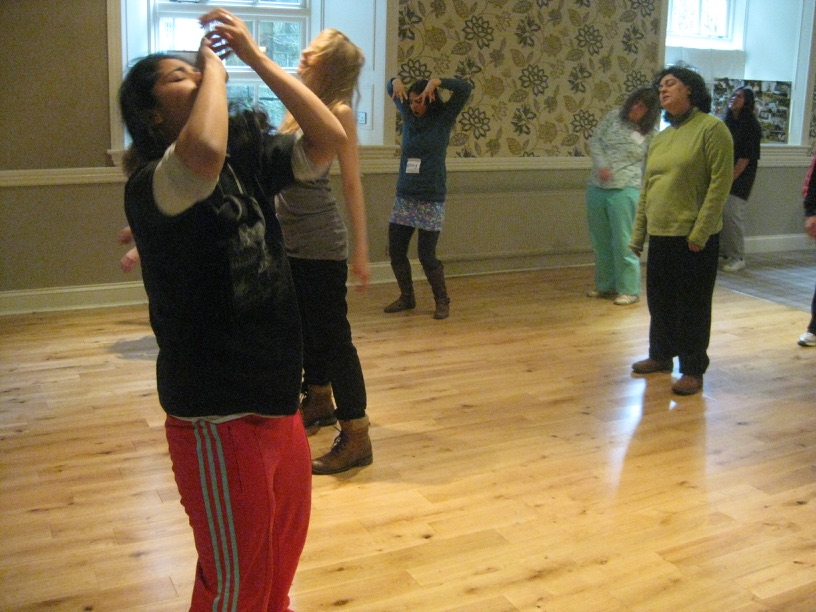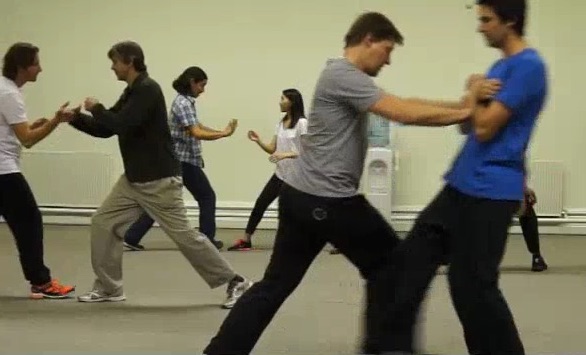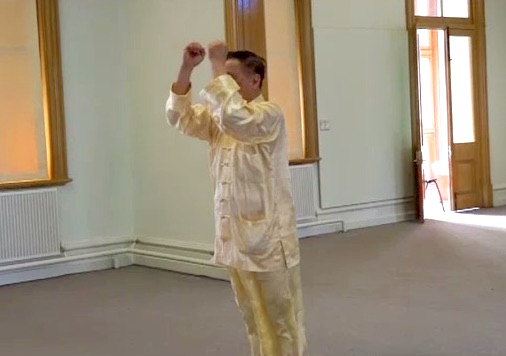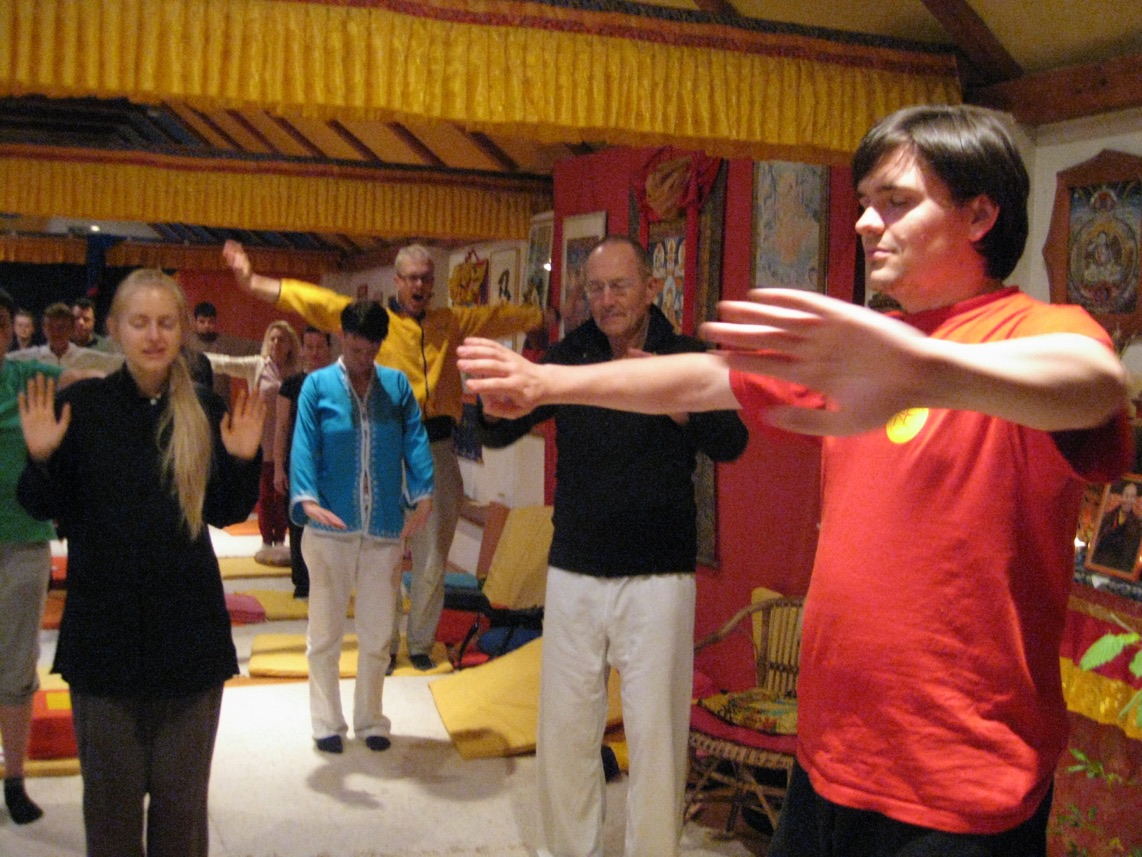SELECTION OF QUESTIONS AND ANSWERS
NOVEMBER 2016 PART 1

Chi flow
Question 1
Could you share some details on practicing bigu? For example, are there specific techniques or skills I should practice while attempting bigu? Do you have any advice for someone who wants to practice it?
— David, USA
Answer
I practiced bigu, or abstinence from eating food, about 30 years ago. I did not have any preparation. I just started bugu, and it was successful. This was due to my many years of chi kung training. Starting bigu without appropriate training is certainly not advisable for most people.
I did bigu for about 20 days, during which time I did not feel any adverse effects in my daily life. In fact I felt more mentally clear and had more energy. I taught kungfu, which involved vigorous sparring, as usual. I could have continue my bigu but stopped because of a chi kung graduation dinner.
I tried bigu because, in my idealism in my younger days, I thought of teaching poor people how to go about life without taking food. But later I realized it was not a practical approach because of the following reasons:
- Capable people teaching poor people how to manage their resources is more effective than me teaching poor people bigu.
- The poor people may not be interested in or learning bigu.
- It would take some time to teach student first to attain a reasonable high level of chi kung training before teaching them bigu.
Hence, my advice for those who want to practice bigu is that bigu may not have much functional value. If they want to try bigu for fun or for an experience, it is fine, provided that they ensure themselves that they would not suffer any adverse effects.
It is advisable to approach bigu gradually. Have some light food, like chocolate and milk on the first one or two days before attempting to go without food totally.
In my case, and I believe also in the case of advanced students in our school, Shaolin Wahnam, they can attempt bigu without any special techniques. This is because our chi kung training enables us to adjust to changing conditions, i.e. without taking food, within a very short time.
I do not know any special techniques for bigu. You would have to seek a special bigu teacher.
Question 2
When an opponent pushes at you in Taijiquan Pushing Hands, do you always push him to your right side when you apply the tactic of interception.
— James, Australia
Answer
No, it is not always. It depends on to which direction he is pushing you, and also on how you intercept his push.
Suppose he pushes you to your right side, and you wish to intercept him using an anti-clockwise movement. In this case you step to your left side and push him to your right side.
If he pushes you to your left side, and you intercept him using a clockwise movement. In this case you step to your right side and push him to your left side.
What would you do if he pushes you frontally? You sink back your body, immediately move to either side, and push him towards your back (when you were facing him) in the same direction as he pushes you.

Taijiquan Pushing Hands
Question 3
I finally convinced my mom to learn Shaolin Chi Kung from Sifu (Sifu Eugene Siterman) in New York. Sifu did an excellent job in initiating her into chi flow. My mother commented that she felt as if she acquired a treasure. I myself never imagined that she would respond so well to the transmission!
I told her that with consistent practice she would soon get rid of her insomnia, body aches and mild depression!
— Stephen, USA
Answer
I am glad that your mother eventually practices chi kung. Indeed she has received a treasure that will give her good health, vitality and longevity.
Your sifu, Eugene, is an excellent teacher. Your mother will do well under his care. Her health problems of insomnia, body aches and mild depression are relatively minor. Overcoming these problems is a matter of course if she continues to practice daily.
Question 4
A few days into practice, however, she was beginning to worry that her chi flow and swaying had not been as strong as when in Sifu's presence. I mentioned to her that this was a normal course of development and asked her to continue to keep practicing twice a day for 15 minutes. I also pointed out to her that she didn't believe chi existed a few days ago!
Answer
You are perfectly right in telling your mother that her chi flow will naturally be less when she is not in the presence of a chi kung master like Eugene. You are also right in telling her not to overtrain.
In fact, if your mother can get about 30% of the benefit she got when learning from Eugene, it is right. If she gets as much benefit as she got when learning from Eugene, it will certainly be over-training. I repeat: she should get just about 30% of the benefit she got when learning from Eugene. Tell her that this advice comes from me, and I base my advice from teaching thousands of students, including some who have over-trained.
It is difficult for many people to believe that getting just 30% of what they got when learning from a Shaolin Wahnam master is enough for their needs and aspirations, and that getting more will lead to over-training. Many people want to get more benefit in their training. This is understandable, especially when many chi kung students do not get any real chi kung beneifts as they only perform gentle physical exercise. I repeat: for your mother or any of our Shaolin Wahnam student, getting just 30% of the benefit they got when learning from a Shaolin Wahnam master is enough. Getting more will lead to over-training.

"Pulling Body" in sinew Metamorphosis
Question 5
When I visit my mom to see her practice, can I apply what I learned from the Dragon Strength course to help enhance her chi flow after she has completed her 15 repetitions of Lifting the Sky? Sigung taught us how to open vital points and stroke a few feet away from the body to clear blockages. I've also noticed that her chi flow is better when I stand near her. However, I don't want her receive too much energy and overtrain.
Answer
There is no need for you to enhance your mother's chi flow. If you do it correctly, it will lead to her over-training. If you do it wrongly, you give her adverse effects. But give her encouragement. You can stand around her when she practices if you like.
Question 6
I enjoyed reading the thread on the 72 Shaolin Arts on our forum. You mentioned several arts practised in Shaolin Wahnam, including "Lifting-Practice-Art". I imagine "Lifting-Practise-Art" is similar to "Consistent-Lifting-Art"' of Ngok Ka Kungfu.
From your wonderful autobiography I could gather that Consistent-Lifting-Art involves doing patterns similar to "Reaching Up" and "Pulling Body" from Sinew Metamorphosis, followed by hitting yourself with bean bags and progressing to heavier materials.
As I love Sinew Metamorphosis very much, even more so after your wow-course on it during Summer Camp this year, I cannot help but being fascinated by the "Lifting Practise Art" you mentioned. Could I ask you to tell a bit about it? Is it indeed similar to the 'Consistent Lifting Art' of Ngok Ka Kung Fu?
— Situ Roeland Dijkema, the Netherlands
Answer
Yes, Lifting-Practice-Art is the same as Consistent-Practice-Art. In Chinese (Cantonese) it is Thiew-Hung-Kung. It is an exclusive internal art in Ngok Ka Kungfu taught only to selected disciples.
When I translated Thiew-Hung-Kung into English, sometimes I used Lifting-Practice-Art, and sometimes Consistent-Practice Art. It is not easy to translate Chinese terms into English. The two translated terms I used were the closest I could get to convey the Chinese meaning.
You are again correct to say that Lifting-Practice-Art is like "Reaching Up" and "Pulling Body" from Sinew Metamorphosis. Another exercise often used in Lifting-Practice-Art is "Double Hooks Hanging on a Wall" from the Eighteen-Lohan Art.
Lifting-Practice-Art or Consistent-Practice-Art is the method. The result is Thirteen Grand Guards or Sap Sam Tai Po in Chinese (Cantonese). In other words, when a practitioner successfully completed his training of Lifting-Practice-Art, usually for a few years, he attains the ability of Thirteen Grand Guards.
Sifu Chow Kok Chee, who was my childhood friend with whom I exchanged some kungfu arts, told me an interesting story when he was training Lifting-Practice-Art taught to him by his god-father, Loong Poh. Loong Poh was his nick-name, meaning Deaf Poh. His real name was Chan Khun Poh.
Sifu Chan Khun Poh was a patriarch of Ngok Ka Kungfu, the family style of kungfu transmitted by the Martial Sage, Marshal Yue Fei. "Ngok Ka" is in Cantonese. In Manderin it is "Yue Jia" which means "Yue Family". Sifu Chan Khun Poh made a mistake while training Lifting-Practice-Art. His sifu gave him a slap so hard that he became deaf for life.
Sifu Chow Kok Chee told me that when he was training "Reaching Up", which was one of the exercises in Lifting-Practice-Art, he had to grip $50 notes between his fingers. The only difference between "Reaching Up" in Lift-Practice-Art and in Sinew Metamorphosis is that in Lift-Practice-Art a practitioner remains stationary but in Sinew Metamorphosis he stretches his arms though the stretching is not noticeable to the uninitiated. If any of the $50 notes slipped his fingers and dropped to the ground, his god-father would confiscate them. At that time in the 1960s, $50 was a lot of money.
I don't know how many $50 notes were confiscated, but it was worth it as the resultant Thirteen Grand Guands saved Sifu Chow Kok Chee's life. Once he was ambushed by a group of attackers, and one of them chopped a scimitar onto his back, and he could have been in two pieces had it not for his Thirteen Grand Guards. He still has a long scar on his back as a souvenir.

Sifu Anton in the foreground performing "Separating Water"
Question 7
The other art which you mentioned and that I could not find anything on is 'Separating Water Art'. I would love to hear anything you could spare on this art.
Answer
In Separating Water Art a practitioner performs "Green Dragon Separates Water" or "Separating Water" for short, not just about 8 to 10 times but hundreds of times. He has to progress gradually. He starts with just a few times and eventually he reaches hundreds of times per training session. As he progresses, he may add weights, like copper rings, to his arms.
His resultant art is Iron Arm, where he can break an opponent's arm or deflect an opponent's bladed weapon easily.
There are different methods to train the resultant art of Iron Arm. Besides Separating Water, a practitioner may use Rolling Bamboo, striking a wooden man or striking poles.
Using the Separating Water method is internal. The practitioner's arms are not only powerful, the internal force derived from the training also gives him good health, vitality and longevity. Using striking a wooden man or striking poles method is external. Apart from having powerful arms, there are no holistic benefits. Using the Rolling Bamboo method is both internal and external.
Question 8
Thank you for sharing your arts so generously. The longer I practise, the more I am amazed by all that you share.
Answer
Our school is known to be very generous. When other masters keep their secrets, we share our secrets quite openly.
There are a few reasons for our generosity. As we are sincere in preserving genuine arts, we have to share our secrets, otherwise students will only have external forms without the essence.
Secondly, we have many secrets whereas other schools have only a few. Theredore we can afford to be generous. As an analogy, if you have a thousand dollars, you can afford to give away a few hundreds. If you have only ten dollars, you may prefer to keep it.
Thirdly, our training makes us generous intrinsicly. Our training opens our heart, let our chi flow, and make us happy and free. Other people tense their muscles and block their energy. When your heart is open and you feel free and happy, you are more likely to be generous.
LINKS
Selected Reading
- Lady Immortal Temple and White Water Waterfall
- We Have Reached a Very Rare and Privileged Stage of Development in our School
- Learning the Eighteen Loha n Fist
- Across the Apalachain
- Marital Duties and Kungfu Training
